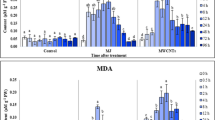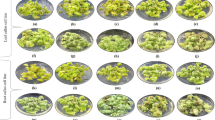Abstract
Satureja khuzistanica is a medicinal herb endemic to Iran which can serve as a source of rosmarinic acid (RA). In the present study, the effect of different concentrations of methyl jasmonate (MeJA) and multi-walled carbon nanotubes (MWCNTs) on the rosmarinic acid accumulation and the expression of genes involved in its biosynthetic pathway was evaluated in nodal segment cultures of S. khuzistanica. The concentration of RA varied in plant extracts derived from the field, plants obtained under in vitro solid media, calli, suspension cultures and nodal segment cultures in liquid medium, with the highest amount recorded in nodal segment cultures. Phenylalanine ammonia-lyase (PAL), tyrosine aminotransferase (TAT), 4-hydroxyphenylpyruvate reductase (HPPR) and RA synthase (RAS) cDNA clones as key biosynthetic genes of RA production were identified and expression patterns were assayed in response to MeJA and MWCNTs, exogenously applied at a range of 0, 50, 100, 250 mg L−1. The expression levels of HPPR, PAL and TAT were up-regulated at 100 mg L−1 MWCNTs, whereas down-regulated levels were observed at 250 mg L−1. RAS was up-regulated in all MWCNTs treatments. HPPR, PAL and TAT expression increased sharply at 250 mg L−1 MeJA. The highest levels of RAS transcripts were observed at 100 mg L−1 MeJA. The highest HPPR, PAL and TAT expression levels were observed at 250 mg L−1 MeJA. In accordance, HPLC analysis showed a high amount of RA under MeJA and MWCNT elicitors. Our results provide helpful information on the expression profiles of biosynthetic genes in connection with RA accumulation.









Similar content being viewed by others
Abbreviations
- HPLC:
-
High performance liquid chromatography
- HPPR :
-
Hydroxyphenylpyruvate reductase
- MeJA:
-
Methyl jasmonate
- MWCNTs:
-
Multi-walled carbon nanotubes
- RA:
-
Rosmarinic acid
- PAL :
-
Phenylalanine ammonialyase
- RAS:
-
Rosmarinic acid synthase
- TAT :
-
Tyrosine amino-transferase
References
Al-Dhabi NA, Arasu MV, Park CH, Park SU (2014) Recent studies on rosmarinic acid and its biological and pharmacological activities. EXCLI J 13:1192–1195
Chen H, Chen F (2000) Effect of yeast elicitor on the secondary metabolism of Ti-transformed Salvia miltiorrhiza cell suspension cultures. Plant Cell Rep 19:710–717
Chen AH, Chai YR, Li JN, Chen L (2007) Molecular cloning of two genes encoding cinnamate 4-hydroxylase (C4H) from oilseed rape (Brassica napus). J Biochem Mol Biol 40:247–260
De-Eknamkul W, Ellis BE (1987) Tyrosine aminotransferase: the entrypoint enzyme of the tyrosine-derived pathway in rosmarinic acid biosynthesis. Phytochem 26:1941–1946
Discosmo F, Misawa M (1985) Eliciting secondary metabolism in plant cell cultures. Trends Biotechnol 3:318–322
Dixon RA, Paiva NL (1995) Stress-induced phenylpropanoid metabolism. Plant Cell 7:1085–1097
Esmaeili H, Hadian J, Mirjalili MH, Rezadoost H (2015) The effect of activated charcoal and multi-walled carbon nanotubes on the growth, rosmarinic and caffeic acid content, total phenol, total flavonoid and antioxidant activity of Satureja rechingeri calluses. J Biodivers Environ Sci 6:297–304
Farmer EE, Johnson RR, Ryan CA (1992) Regulation of expression of proteinase inhibitor genes by methyl jasmonate and jasmonic acid. Plant Physiol 98:995–1002
Ghorbanpour M, Hadian J (2015) Multi-walled carbon nanotubes stimulate callus induction, secondary metabolites biosynthesis and antioxidant capacity in medicinal plant Satureja khuzistanica grown in vitro. Carbon 94:749–759
Gundlach H, Mfiller MJ, Kutchan TM, Zenk MH (1992) Jasmonic acid is a signal transducer in elicitor-induced plant cell cultures. Proc Natl Acad Sci USA 89:2389–2393
Hadian J, Mirjalili MH, Kanani MR, Salehnia A, Ganjipoor P (2011) Phytochemical and morphological characterization of Satureja khuzistanica Jamzad populations from Iran. Chem Biodivers 8:902–915
Huang B, Yi B, Duan Y, Sun L, Yu X, Guo J, Chen W (2008) Characterization and expression profiling of tyrosine aminotransferase gene from Salvia miltiorrhiza (Dan-shen) in rosmarinic acid biosynthesis pathway. Mol Boil Rep 35:601–612
Hyun-Jin K, Jorge MF, Ju-Hee C, Chieri K (2007) Effect of methyl jasmonate on phenolic compounds and carotenoids of romaine lettuce (Lactuca sativa L.). J Agric Food Chem 55:10366–10372
Kim YB, Kim JK, Uddin MR, Xu H, Park WT, Tuan PA, Li X, Chung E, Lee JH, Park SU (2013) Metabolomics analysis and biosynthesis of rosmarinic acid in Agastache rugosa Kuntze treated with methyl jasmonate. PLoS ONE 8:e64199
Kintzios S, Makri O, Panagiotopoulos E, Scapeti M (2003) In vitro rosmarinic acid accumulation in sweet basil (Ocimum basilicum L.). Biotechnol Lett 25:405–408
Krzyzanowska J, Janda B, Pecio L, Stochmal A, Oleszek W, Czubacka A, Przybys M, Doroszewska T (2011) Determination of polyphenols in Mentha longifolia and M. piperita field-grown and in vitro plant samples using UPLC-TQ-MS. J AOAC Int 94:43–50
Lahiani MH, Chen J, Irin F, Puretzky AA, Green MJ, Khodakovskaya MV (2015) Interaction of carbon nanohorns with plants: uptake and biological effects. Carbon 81:607–619
Lee BK, Park MR, Srinivas B, Chun JC, Kwon IS, Chung IM, Yoo NH, Choi KG, Yun SJ (2003) Induction of phenylalanine ammonia-lyase gene expression by paraquat and stress-related hormones in Rehmannia glutinosa. Mol Cells 16:34–39
Li X, Kim JK, Park SU (2017) Molecular cloning and characterization of rosmarinic acid biosynthetic genes and rosmarinic acid accumulation in Ocimum basilicum L. Saudi J. Biol Sci. https://doi.org/10.1016/j.sjbs.2017.03.010 (In press)
Liu RR, Xu SH, Li JL, Hu YL, Lin ZP (2006) Expression profile of a PAL gene from Astragalus membranaceus var. Mongholicus and its crucial role in flux into flavonoid biosynthesis. Plant Cell Rep 25:705–710
Low PS, Merida JR (1996) The oxidative burst in plant defense: function and signal transduction. Physiol Plant 96:533–542
Lu X, Hao L, Wang F, Huang C, Wu S (2013) Molecular cloning and overexpression of the tyrosine aminotransferase (TAT) gene leads to increased rosmarinic acid yield in Perilla frutescens. Plant Cell Tissue Organ Cult 115:69–83
MacDonald MJ, D’Cunha GB (2007) A modern view of phenylal-anine ammonia lyase. Biochem Cell Biol 85:273–282
Majdi M, Abdollahi MR, Maroufi A (2015) Parthenolide accumulation and expression of genes related to parthenolide biosynthesis affected by exogenous application of methyl jasmonate and salicylic acid in Tanacetum parthenium. Plant Cell Rep 34:1909–1918
Mizukami H, Ogawa T, Ohashi H, Ellis BE (1992) Induction of rosmarinic acid biosynthesis in Lithospermum erythrorhizon cell suspension cultures by yeast extract. Plant Cell Rep 11:480–483
Mizukami H, Tabira Y, Ellis BE (1993) Methyl jasmonate-induced rosmarinic acid biosynthesis in Lithospermum erythrorhizon cell suspension cultures. Plant Cell Rep 12:706–709
Murashige T, Skoog F (1962) A revised medium for rapid growth and bio assays with tobacco tissue cultures. Physiol Plant 15:473–497
Park WT, Arasu MV, Al-Dhabi NA, Yeo SK, Jeon J, Park JS, Lee SY, Park SU (2016) Yeast extract and silver nitrate induce the expression of phenylpropanoid biosynthetic genes and induce the accumulation of rosmarinic acid in Agastache rugosa cell culture. Molecules 21:426
Petersen M (2013) Rosmarinic acid: new aspects. Phytochem Rev 12:207–227
Petersen M, Simmonds MS (2003) Rosmarinic acid. Phytochem 62:121–125
Petersen M, Ha¨usler E, Karwatzki B, Meinhard J (1993) Proposed biosynthetic pathway for rosmarinic acid in cell cultures of Coleus blumei Benth. Planta 189:10–14
Razzaque A, Ellis BE (1977) Rosmarinic acid production in Coleus cell cultures. Planta 137:287–291
Ru M, Wang K, Bai Z, Peng L, He S, Wang Y, Liang Z (2017) A tyrosine aminotransferase involved in rosmarinic acid biosynthesis in Prunella vulgaris L. Sci Rep 7:4892
Schmittgen TD, Livak KJ (2008) Analyzing real-time PCR data by the comparative CT method. Nat Protoc 3(6):1101
Smetanska I (2008) Production of secondary metabolites using plant cell cultures. Food Biotechnol 111:187–228
Song J, Wang Z (2011) RNAi-mediated suppression of the phenylalanine ammonia-lyase gene in Salvia miltiorrhiza causes abnormal phenotypes and a reduction in rosmarinic acid biosynthesis. J Plant Res 124:183–192
Srivastava S, Conlan XA, Adholeya A et al (2016) Elite hairy roots of Ocimum basilicum as a new source of rosmarinic acid and antioxidants. Plant Cell Tiss Organ Cult 126:19–32. https://doi.org/10.1007/s11240-016-0973-x
Sumaryono W, Proksch P, Hartmann T, Nimtz M, Wray V (1991) Induction of rosmarinic acid accumulation in cell suspension cultures of Orthosiphon aristatus after treatment with yeast extract. Phytochem 30:3267–3271
Szabo E, Thelen A, Petersen M (1999) Fungal elicitor preparation and methyl jasmonate enhance rosmarinic acid accumulation in suspension cultures of Coleus blumei. Plant Cell Rep 18:485–489
Taha RA, Hassan MM, Ibrahim EA et al (2016) Carbon nanotubes impact on date palm in vitro cultures. Plant Cell Tiss Organ Cult 127:525–534. https://doi.org/10.1007/s11240-016-1058-6
Verpoorte R, van der Heijden R, Memelink J (1998) Plant biotechnology and the production of alkaloids: prospects of metabolic engineering. The Alkaloids 50:453–508
Xiangang H, Kaicheng L, Li M, Kang J, Zhou Q (2014) Interactions between graphene oxide and plant cells: regulation of cell morphology, uptake, organelle damage, oxidative effects and metabolic disorders. Carbon 80:665–676
Xiao Y, Gao S, Di P, Chen J, Chen W, Zhang L (2009) Methyl jasmonate dramatically enhances the accumulation of phenolic acids in Salvia miltiorrhiza hairy root cultures. Physiol Plant 137(1):1–9
Xiao Y, Zhang L, Gao S, Saechao S, Di P, Chen J, Chen W (2011) The c4h, tat, hppr and hppd genes prompted engineering of rosmarinic acid biosynthetic pathway in Salvia miltiorrhiza hairy root cultures. PLoS ONE 6:e29713
Xu H, Kim YK, Jin X, Lee SY, Park SU (2008) Rosmarinic acid biosynthesis in callus and cell cultures of Agastache rugosa Kuntze. J Med Plants Res 2:237–241
Yimian MA, Yuan L, Wu B, Xen Li, Chen S, Lu S (2012) Genome-wide identification and characterization of novel genes involved in terpenoid biosynthesis in Salvia miltiorrhiza. J Exp Bot 63:2809–2823
Acknowledgements
This work benefited from financial support from the Bu-Ali Sina University, Hamedan, Iran. The authors extend their sincere appreciation to the Plant and Environmental Biotechnology Lab, Department of Biochemistry and Biotechnology, Thessaly University, Larissa, Greece for their help in performing some parts of the experiments.
Author information
Authors and Affiliations
Contributions
MRA conceived and designed the experiments, FF performed the experiments and wrote the manuscript, AM, DD, CG and KP provided technical advice. All of the authors have read and approved the final version of the manuscript.
Corresponding author
Ethics declarations
Conflict of interest
The authors have declared that no competing interests exist.
Additional information
Communicated by Maria Margarida Oliveira.
Rights and permissions
About this article
Cite this article
Fatemi, F., Abdollahi, M.R., Mirzaie-asl, A. et al. Identification and expression profiling of rosmarinic acid biosynthetic genes from Satureja khuzistanica under carbon nanotubes and methyl jasmonate elicitation. Plant Cell Tiss Organ Cult 136, 561–573 (2019). https://doi.org/10.1007/s11240-018-01537-8
Received:
Accepted:
Published:
Issue Date:
DOI: https://doi.org/10.1007/s11240-018-01537-8




